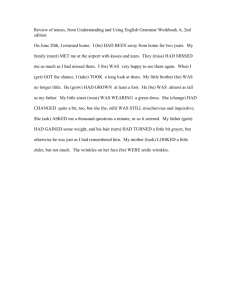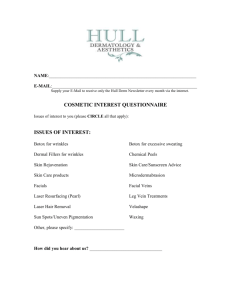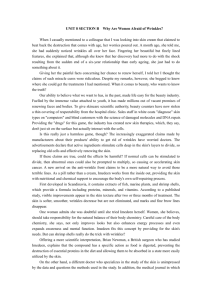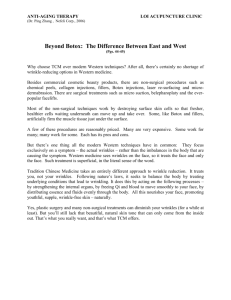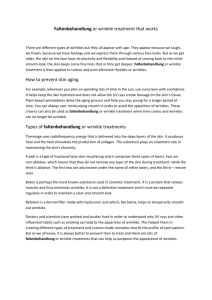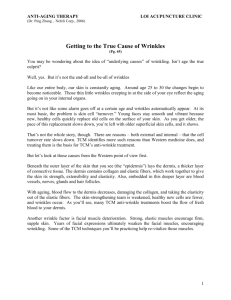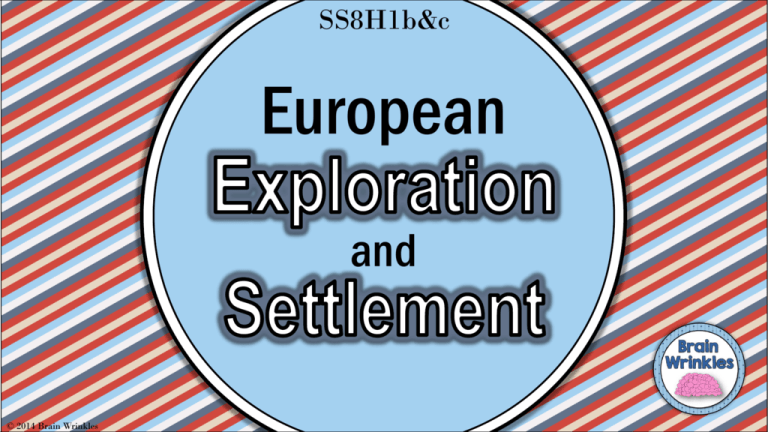
SS8H1b&c
European
and
© 2014 Brain Wrinkles
Standards
SS8H1 The student will evaluate the development of Native American
cultures and the impact of European exploration and settlement on the
Native American cultures in Georgia.
b. Evaluate the impact of European contact on Native American cultures;
cultures; include Spanish missions along the barrier islands, and the
explorations of Hernando De Soto.
c. Explain reasons for European exploration and settlement of North
America, with emphasis on the interests of the French, Spanish, and British
British in the southeastern area.
© 2014 Brain Wrinkles
Teacher Directions – CLOZE Notes
• The next pages are handouts for the students to use for notetaking during the presentation. (Print front to back to save
paper and ink.)
• Check the answers as a class after the presentation.
© 2014 Brain Wrinkles
European Contact
• Spanish _____________________________________________
entered Georgia in the ______________________________ .
• European missionaries attempted to
_____________________________________________ to their
religion.
• They also ______________________________ that wiped out a
large portion of the native population.
Hernando De Soto
• In ______________________________ , a Spanish conquistador
named ______________________________ led 600 soldiers across
Georgia.
• De Soto was searching for “______________________________ ”.
• De Soto’s men
_____________________________________________ the natives
in order to gain information about gold and silver locations.
• He ______________________________ , but he did leave a lasting
impact on the Native Americans in Georgia.
Diseases
• De Soto and other Spanish explorers
_____________________________________________ that
devastated the Native American population.
• Some of the diseases included ______________________________ ,
influenza, ______________________________ , and chicken pox.
• The natives had ______________________________ to the diseases.
diseases.
• ______________________________ were wiped out at a time.
Missions
• In 1565, the Spanish
_____________________________________________ , Florida as
their first permanent settlement.
• Then they moved north to establish posts on some of
_____________________________________________ including
St. Catherine’s, Cumberland, ______________________________ ,
and Sapelo Islands.
• They established ______________________________ ) in all of these
these places with the goal of converting Native Americans to the
______________________________ .
© 2014 Brain Wrinkles
The 3 G’s
• GOLD: Many of the explorations were for economic reasons. Explorers were
__________________________________________________ .
• GOD: Another reason for exploration was a desire to
______________________________ to other lands.
• GLORY: Many explorers were driven by personal ambition for
______________________________ .
New World
• Beginning in 1400, _____________________________________________ competed
competed to conquer and claim ______________________________ .
• In the 1490s, ______________________________ was given ships and sailors by the
Spanish monarchy.
• His goal was to find a quick ______________________________ through the Atlantic
Atlantic Ocean.
• Columbus didn’t make it to Asia, but actually landed in the
______________________________ …
Spain
• Exploration of the New World brought ______________________________ to Spain.
Spain.
• Spain had a ______________________________ that spanned the globe.
• By the 1500s, the Spanish had established numerous settlements from
______________________________ .
Great Britain
• Great Britain began exploring the New World in the
______________________________ .
• British explorers hoped to _________________________________________ that
they could use to manufacture goods in their own country.
• Great Britain settled the ______________________________ (from Georgia to
Maine) from 1607 to 1732.
France
• French explorers traveled to the New World in the ___________________.
• In 1603, French explorers found great
_________________________________________ in eastern Canada and claimed
the area for France.
• This became the center for the ______________________________ in the New
World.
• The French also explored along the Mississippi River and established settlements like
______________________________________________ .
Native Americans
• As the Europeans ______________________________ in the Americas, they had
______________________________________________________ living in the
areas.
• Many natives were _______________________________________ from diseases.
• The Europeans were only interested in the natives for trading,
______________________________ , and military alliances.
© 2014 Brain Wrinkles
European Contact
• Spanish explorers and missionaries entered Georgia in the early 1500s.
© 2014 Brain Wrinkles
The 3 G’s
• GOLD: Many of the explorations were for economic reasons. Explorers were
seeking riches such as gold.
• GOD: Another reason for exploration was a desire to spread religion to other lands.
• GLORY: Many explorers were driven by personal ambition for glory and fame.
New World
• Beginning in 1400, Spain, France, and Great Britain competed to conquer and claim
claim land in North America.
• In the 1490s, Christopher Columbus was given ships and sailors by the Spanish
monarchy.
• His goal was to find a quick route to Asia through the Atlantic Ocean.
• Columbus didn’t make it to Asia, but actually landed in the Bahamas…
Spain
• Exploration of the New World brought great wealth to Spain.
• Spain had a huge empire that spanned the globe.
• By the 1500s, the Spanish had established numerous settlements from Florida to
Georgia.
Great Britain
• Great Britain began exploring the New World in the late 15th century.
• British explorers hoped to find raw materials that they could use to manufacture
goods in their own country.
• Great Britain settled the 13 colonies (from Georgia to Maine) from 1607 to 1732.
France
• French explorers traveled to the New World in the 1600s.
• In 1603, French explorers found great numbers of beaver in eastern Canada and
claimed the area for France.
• This became the center for the fur trade in the New World.
• The French also explored along the Mississippi River and established settlements
like New Orleans and Mobile.
Native Americans
• As the Europeans competed for land in the Americas, they had little regard for
Native Americans living in the areas.
• Many natives were enslaved or killed from diseases.
• The Europeans were only interested in the natives for trading, land deals, and
military alliances.
© 2014 Brain Wrinkles
SS8H1b&c
European
and
© 2014 Brain Wrinkles
SS8H1b
on Native Americans
© 2014 Brain Wrinkles
•
Spanish explorers and missionaries entered Georgia in
the early 1500s.
•
European contact made a dramatic impact on the
Native Americans.
•
European missionaries attempted to convert the
natives to their religion.
•
They also brought diseases that wiped out a large
portion of the native population.
© 2014 Brain Wrinkles
© 2014 Brain Wrinkles
•
In 1540, a Spanish conquistador named Hernando De Soto
led 600 soldiers across Georgia.
• De Soto was searching for “cities of gold”.
•
De Soto’s men tortured and enslaved the natives in order to
gain information about gold and silver locations.
•
He never found the gold, but he did leave a lasting impact
on the Native Americans in Georgia.
© 2014 Brain Wrinkles
Hernando De Soto
© 2014 Brain Wrinkles
As Hernando De Soto
marched throughout
the Southeast,
thousands of Native
Americans were
tortured and killed by
his men.
© 2014 Brain Wrinkles
•
De Soto and other Spanish explorers brought horrible
diseases that devastated the Native American population.
•
Some of the diseases included smallpox, influenza, measles,
and chicken pox.
•
The natives had no resistance to the diseases.
•
Entire villages were wiped out at a time.
© 2014 Brain Wrinkles
•
In 1565, the Spanish established St. Augustine, Florida as
their first permanent settlement.
•
Then they moved north to establish posts on some of
Georgia’s barrier islands, including St. Catherine’s,
Cumberland, St. Simons, and Sapelo Islands.
•
They established missions (churches) in all of these places
with the goal of converting Native Americans to the
Catholic religion.
© 2014 Brain Wrinkles
Spanish Missions were established along
the barrier islands to convert natives to
Christianity.
© 2014 Brain Wrinkles
SS8H1c
© 2014 Brain Wrinkles
Why did Europeans go exploring?
I. GOLD: Many of the explorations were for economic reasons.
Explorers were seeking riches such as gold.
II. GOD: Another reason for exploration was a desire to spread
religion to other lands.
III. GLORY: Many explorers were driven by personal ambition
for glory and fame.
© 2014 Brain Wrinkles
© 2014 Brain Wrinkles
•
Beginning in 1400, Spain, France, and Great Britain
competed to conquer and claim land in North America.
•
In the 1490s, Christopher Columbus was given ships and
sailors by the Spanish monarchy.
• His goal was to find a quick route to Asia through the
Atlantic Ocean.
•
Columbus didn’t make it to Asia, but actually landed in the
Bahamas…
© 2014 Brain Wrinkles
Christopher Columbus
© 2014 Brain Wrinkles
© 2014 Brain Wrinkles
•
Exploration of the New World brought great wealth to
Spain.
•
Spain had a huge empire that spanned the globe.
•
By the 1500s, the Spanish had established numerous
settlements from Florida to Georgia.
© 2014 Brain Wrinkles
Spanish Missions and Forts
Along Georgia & Florida’s
Coast
© 2014 Brain Wrinkles
•
Great Britain began exploring the New World in the
late 15th century.
•
British explorers hoped to find raw materials that they
could use to manufacture goods in their own country.
•
Great Britain settled the 13 colonies (from Georgia to
Maine) from 1607 to 1732.
© 2014 Brain Wrinkles
© 2014 Brain Wrinkles
•
French explorers traveled to the New World in the 1600s.
•
In 1603, French explorers found great numbers of beaver
in eastern Canada and claimed the area for France.
• This became the center for the fur trade in the New
World.
•
The French also explored along the Mississippi River and
established settlements like New Orleans and Mobile.
© 2014 Brain Wrinkles
© 2014 Brain Wrinkles
•
As the Europeans competed for land in the Americas,
they had little regard for Native Americans living in
the areas.
•
Many natives were enslaved or killed from diseases.
•
The Europeans were only interested in the natives for
trading, land deals, and military alliances.
© 2014 Brain Wrinkles
© 2014 Brain Wrinkles
Teacher Info – Citation for Injustice
• Print off the Citation for Injustice handout for each student.
• The students will write a “ticket” to Hernando de Soto (Offender) for
his poor treatment of Native Americans. They should describe how the
explorer treated Native Americans (took land, spread diseases,
enslaved, killed, etc.). Then, they will write how they think de Soto
should have treated the Indians.
• In the “polaroid picture”, they will draw a scene that shows the poor
treatment of Native Americans.
© 2014 Brain Wrinkles
© 2014 Brain Wrinkles
Ticket Number 67483928-22
Offender:
Date:
Describe the Offense:
Instead, the lawbreaker should have:
Photographic Evidence
Signature:
Teacher Info – Explorer Job Application
• Print off the Job Application handout for each student.
• The students will complete a job application as if they were interested
in being an explorer during the 1500s. They should think about what
an explorer did, the motivation behind exploring, etc., when
completing the application.
• In the picture box, the students will draw a picture of themselves as an
explorer in action.
© 2014 Brain Wrinkles
Applicant:
Age:
Location:
•
Do you like taking risks? Describe the biggest adventure that you’ve been on.
•
Are you interested in making a lot of money? What would you do with a chest full of gold?
•
What is your religious preference? How do you feel about forcing others to convert to your
religion?
•
Would you like to be famous? What would you do with fame and glory?
Your Skills in Action
© 2014 Brain Wrinkles
Teacher Directions – Extra! Extra!
• The students will write a news article about the European
countries’ impact on the Americas (exploration, contact with
natives, settlement) as if they were alive during the time
period.
• They will write a catchy headline in the top box.
• They will draw an illustration and a caption in the photograph
section.
© 2014 Brain Wrinkles
Directions: Write a news article that describes European countries impact on the Americas – from exploration to contact with natives, to settlement. Add a catchy headline (top box) and an
action shot (snapshot box).
Date:
Article By:
© 2014 Brain Wrinkles
$
Teacher Directions – Ticket Out the Door
• Have the students complete a Ticket Out the Door at the end
of the lesson.
• They will spend 3-5 minutes and write down all of the
important things that they learned about European
exploration, contact with Native Americans, and settlement in
the New World.
© 2014 Brain Wrinkles
Write down the most important things that you can remember about
European exploration, contact with Native Americans, and settlement in
the New World.
Write down the most important things that you can remember about
European exploration, contact with Native Americans, and settlement in
the New World.
© 2014 Brain Wrinkles
© 2014 Brain Wrinkles
Thank you so much for downloading this file. I sincerely hope you find it helpful and that your students
learn a lot from it! I look forward to reading your feedback in my store.
If you like this file, you might want to check out some of my other products that teach social studies topics
in creative, engaging, and hands-on ways.
Best of luck to you this school year,
Ansley at Brain Wrinkles
© 2014 Brain Wrinkles
© 2014 Brain Wrinkles. Your download includes a limited use license from Brain Wrinkles. The purchaser may use the resource
for personal classroom use only. The license is not transferable to another person. Other teachers should purchase their own
license through my store.
This resource is not to be used:
• By an entire grade level, school, or district without purchasing the proper number of licenses. For school/district licenses at a
discount, please contact me.
• As part of a product listed for sale or for free by another individual.
• On shared databases.
• Online in any way other than on password-protected website for student use only.
© Copyright 2014. Brain Wrinkles. All rights reserved. Permission is granted to copy pages specifically designed for student or teacher use by the original purchaser or
licensee. The reproduction of any other part of this product is strictly prohibited. Copying any part of this product and placing it on the Internet in any form (even a
personal/classroom website) is strictly forbidden. Doing so makes it possible for an Internet search to make the document available on the Internet, free of charge, and is a
violation of the Digital Millennium Copyright Act (DMCA).
Clipart, fonts, & digital papers for this product were purchased from:
Thank you,
Ansley at Brain Wrinkles
© 2014 Brain Wrinkles

